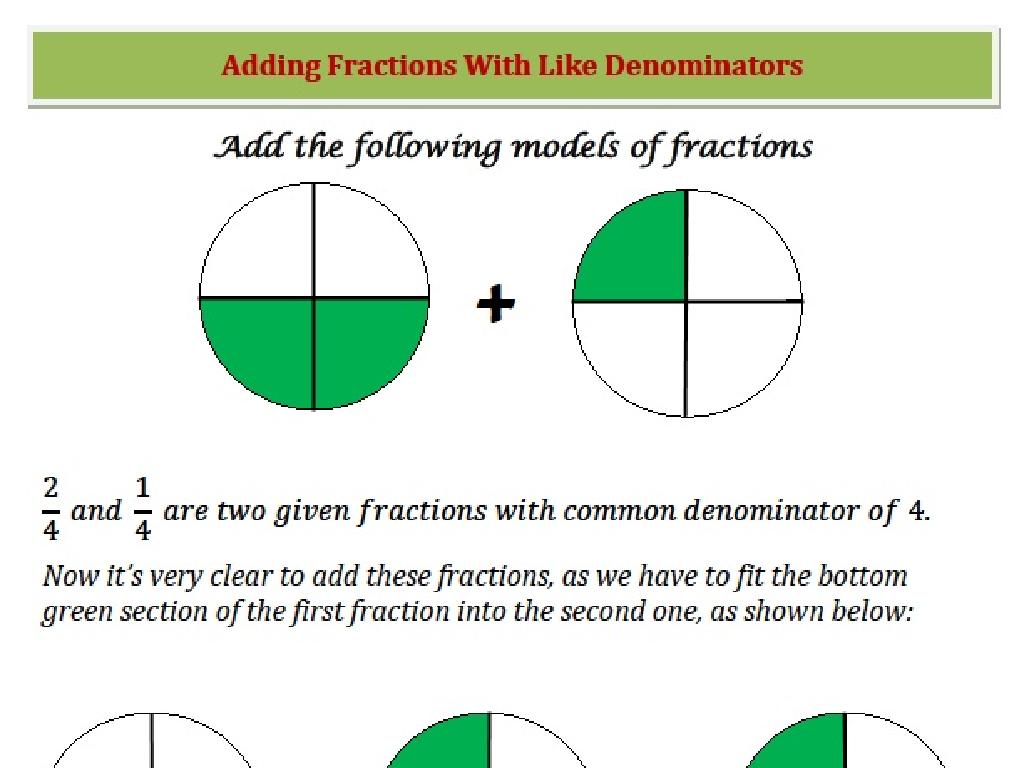Identify Adjectives
Subject: Language arts
Grade: Third grade
Topic: Adjectives And Adverbs
Please LOG IN to download the presentation. Access is available to registered users only.
View More Content
Introduction to Adjectives
– What are adjectives?
– Words that tell us more about nouns
– Adjectives describe nouns
– They give us details like size, color, and speed
– Examples: ‘big’, ‘colorful’, ‘quick’
– ‘Big tree’, ‘colorful flowers’, ‘quick rabbit’
|
This slide introduces the concept of adjectives to third-grade students. Begin by explaining that adjectives are special words used to add information about nouns, which are people, places, things, or ideas. Emphasize that adjectives can tell us more about the size, color, shape, feeling, sound, and many other qualities of a noun. Use simple and familiar examples to illustrate the point, such as ‘big’ to describe a tree, ‘colorful’ for flowers, or ‘quick’ for a rabbit. Encourage the students to think of their own examples and to look for adjectives in their favorite books or stories. This will help them understand how adjectives make descriptions more vivid and interesting.
The Power of Adjectives
– Adjectives enhance writing
– They paint mental images
– Example: ‘The cat’
– Just a subject, no description
– Example: ‘The fluffy, striped cat’
– Descriptive words give us a clear, vivid picture
|
This slide aims to show students how adjectives can make their writing more descriptive and interesting. Adjectives are words that describe nouns and can add detail to help the reader visualize what is being discussed. For example, the phrase ‘The cat’ is plain and doesn’t give the reader much information. However, ‘The fluffy, striped cat’ helps the reader imagine what the cat looks like. Encourage students to think of adjectives as ‘coloring’ words that add life to their sentences. Have them practice by taking simple sentences and adding adjectives to create a more vivid picture.
Exploring Adjectives
– Adjectives describe nouns
– They tell us what kind, which one, how many, or how much
– Example: ‘The tall tree has green leaves.’
– ‘tall’ describes the tree, ‘green’ describes the leaves
– Activity: Find adjectives in sentences
– Look for words that give more information about nouns
|
This slide introduces adjectives to third-grade students, explaining their role in providing more information about nouns. Start by defining adjectives and discussing the types of questions they answer about nouns. Use the example sentence to point out adjectives and explain how they modify nouns. For the activity, provide sentences and have students identify the adjectives. This exercise helps students understand the concept of adjectives and how to use them to add detail to their writing. Encourage students to think of their own examples and share them with the class. Possible activities include identifying adjectives in a favorite book, writing sentences with adjectives, or creating a descriptive paragraph about an object using adjectives.
Adjectives in Action
– Understanding adjectives
– Adjectives are words that describe nouns.
– Creating sentences with adjectives
– Let’s make our own sentences sparkle with adjectives!
– Teacher provides a noun
– Students describe using adjectives
– Example: ‘dog’ becomes ‘The playful, brown dog barked loudly.’
|
This slide is aimed at helping students understand and use adjectives effectively. Begin by explaining that adjectives are words used to describe or modify nouns, giving more information about an object’s size, shape, age, color, etc. Encourage students to think creatively and come up with various adjectives for the nouns you provide. Use the example to illustrate how adjectives can add detail and interest to a sentence. For the activity, provide a list of nouns and have students create sentences using adjectives. Possible nouns include ‘tree’, ‘car’, ‘book’, ‘house’, ‘cat’. This exercise will help reinforce their understanding of adjectives and improve their descriptive writing skills.
Comparing with Adjectives
– Adjectives can compare things
– Use ‘-er’ to compare two things
– ‘shorter’ than, ‘bigger’ than
– Use ‘-est’ for more than two
– ‘shortest’ in the group, ‘biggest’ of all
– Examples: ‘taller’ vs. ‘tallest’
– ‘Jim is taller than Bob. Sam is the tallest.’
|
This slide introduces the concept of comparative and superlative adjectives to the students. Explain that adjectives can be used to compare things, and we change the form of the adjective depending on how many things we are comparing. When comparing two things, we add ‘-er’ to the end of the adjective. For comparing more than two things, we use ‘-est’. Provide clear examples for each case, and encourage students to think of their own examples. You can also introduce irregular adjectives that do not follow this rule, such as ‘good, better, best’. Have students practice by comparing objects in the classroom or characters in a story they are familiar with.
Class Activity: Adjective Hunt
– Find adjectives in our classroom
– Write down descriptive adjectives
– Look for words that describe color, size, shape, etc.
– Share your adjectives with peers
– Discuss the use of adjectives
– Why are these adjectives effective?
|
This activity is designed to help students identify and understand the use of adjectives in their immediate environment. Encourage the students to observe their surroundings and think about the characteristics of the objects they see. They should write down descriptive words that indicate color, size, shape, and other qualities. Afterward, create a sharing session where students can discuss the adjectives they’ve found and why they chose them. This will help them to understand how adjectives enhance descriptions and the importance of word choice in language. Provide guidance and examples if needed, and ensure that every student participates in the discussion.
Conclusion: Adjectives Make Sentences Exciting!
– Adjectives add flavor to sentences
– Homework: Write 10 sentences
– Create sentences about your day or favorite things
– Use a variety of adjectives
– Try to use adjectives we learned today
– Share your sentences tomorrow
|
As we wrap up today’s lesson on adjectives, remind the students how adjectives make our sentences more interesting by describing nouns. For homework, they should write 10 sentences that include a range of adjectives. Encourage them to think creatively and use adjectives that are vivid and descriptive. They can write about their day, their pets, or anything they like. This exercise will help reinforce their understanding of adjectives and how they can enhance their writing. Be prepared for a sharing session tomorrow where each student will read a few of their sentences. This will not only help them practice speaking but also listening to how adjectives can change the meaning and tone of a sentence.






